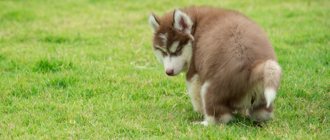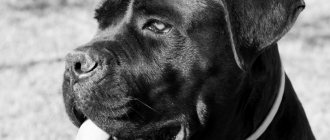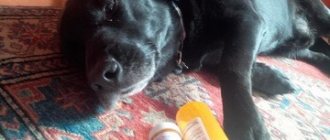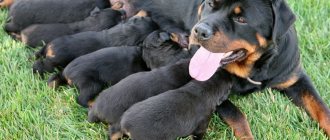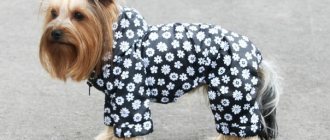Hernia - what is it?
If an animal has a bulging formation in the abdominal area, it may be an inguinal hernia. It occurs as a result of damage to the tissues of the abdominal cavity, or rather their rupture. Because of this, the internal organs cannot be held inside and protrude through the resulting opening, called the hernial orifice. The bag can be filled with the bladder, intestines, mesentery, and uterus. The dog develops an inguinal hernia on both sides or only on one. Depending on the origin, it is divided into types: acquired and congenital.
Rehabilitation
The rehabilitation process varies depending on the severity of the pathology. This period takes from several weeks to several months.
Dogs require special care after surgical treatment of a herniated disc. It is recommended to place your pet in a cage for a sufficiently long time to limit physical activity. The dog is only allowed out to feed and relieve itself. Afterwards, it is recommended to gradually introduce gentle loads - light walking, massage. Rehabilitation swimming has a beneficial effect on such patients. The dog is treated by a specialist who controls the pet’s mobility in the water and does special exercises with it. Unfortunately, this service is found mainly only in large veterinary centers and is not available to everyone due to the high price.
In other cases, daily treatment of the sutures is recommended (until complete healing and removal of the suture material), following a light diet and restricting mobility for 2-3 weeks.
Acquired hernia
Acquired inguinal hernia in dogs of small and large breeds is formed as a result of trauma. The latter include being hit by a car or other vehicle, strong impacts, and mechanical damage received in skirmishes with other animals. A hole in the abdominal cavity occurs due to a sharp increase in pressure in this area. It can be triggered by diseases such as frequent constipation, problems with the cardiovascular system and kidneys. An inguinal hernia can also appear after a difficult birth.
Treatment
Treatment consists of surgery. During this procedure, the doctor examines the hernial opening, returns the prolapsed internal organs to the abdominal cavity, and makes sure of their integrity. If infringement has occurred and some of the prolapsed organs have become necrotic, such areas are removed. After this, the hernial opening is sutured.
If treated in a timely manner, the operation does not take much time, and the prognosis for recovery is favorable. In advanced cases, when infringement and disruption of the prolapsed organs have already occurred, the prognosis will depend on the speed of contacting a doctor, the characteristics of the pathology and the individual characteristics of the dog
Inguinal hernia in a dog: causes
Let's highlight the main reasons that can lead to the formation of an inguinal hernia. If it is congenital, then everything is very clear. And a large number of factors can provoke the occurrence of an acquired one. This pathology develops due to relaxation of the inguinal ring, as well as due to insufficient strength of the walls of the pelvic area.
Every owner should know what can cause an inguinal hernia in dogs of small and large breeds. These factors include:
- Pregnancy.
- Pathology of peritoneal tissue fusion.
- Too much physical activity.
- Bladder fullness.
- Reduction of adipose tissue in the inguinal canal.
- Accumulation of fluid in the abdominal cavity.
- Obesity.
- Weakening of muscle tone.
Preventing the development of a hernia in a pet
Hernial neoplasms are not so common; pathology can be easily avoided if you monitor the pet’s condition, examine its body, respond to changes in mood, and periodically show it to the veterinarian. To prevent the appearance of a muscle tear, it is enough to follow the rules:
- It is necessary to promptly treat problems of the digestive system and other disorders in the functioning of the body, normalize nutrition, and monitor the process of bowel movements;
- It is better to sterilize females not intended for bearing and giving birth to offspring (the same applies to males);
- After injuries or falls, it is important to have the animal examined in a clinic;
- The main condition for keeping a dog is the required amount of physical activity, proper training, regular walking (to avoid obesity or excessive strain on the muscles);
- To operate on a pet (for any reason), select a trusted clinic, and during the recovery period you need to strictly follow the veterinarian’s instructions and take care of the sutures;
- Elderly animals are fed special foods with a high calcium content;
- Dogs are purchased only from trusted breeders. It is important to first get acquainted with the puppy’s parents and find out about their chronic diseases.
To avoid the appearance of a hernia in puppies, a specialist obstetrician is invited during childbirth to help the female without injuring the offspring.
Any hernial neoplasm needs to be examined by a doctor. Therefore, if a lump (reducible or hard) appears, it is necessary to contact your local veterinarian and undergo examination, and then rehabilitation.
Classification
Inguinal hernia in dogs can come in three forms. They are classified according to the condition of the bag:
- Disadvantaged. The peculiarity of this form is that the organs have already fallen into the hernial sac, but the muscle tissue of the abdominal cavity remains dense. Accordingly, this leads to their compression. The danger lies in the obstruction of normal blood circulation. The animal feels severe pain and swelling may occur. After some time, the organs lose the ability to function properly, which can lead to death. In this form, treatment is prescribed immediately.
- Reducible. It is asymptomatic. There are no painful spasms. The abdominal tissues stretch while remaining elastic. The contents of the hernial sac move unhindered. Easily adjusts when pressed or while the animal is moving. To determine the density of the bag's size and shape, a special medical diagnostic method called auscultation is used.
- Irreversible. This form has a characteristic feature - adhesive processes. The organs that fill the bag have already merged with its tissues. When you click on a formation, you can’t straighten it. Fabrics lose elasticity. An inflammatory process may develop, which subsequently develops into fibrosis.
Basic information and varieties
A hernia is a rupture in the muscle tissue or serous layer. Through this damage, the insides become visible from the outside and sag.
Most of these pathologies are considered relatively safe for the patient. In situations where the insides of the bag are pinched by the muscular walls, the situation can have serious complications. The good news is that most types of hernias respond well to treatment. Unfortunately, there are not many ways to treat a hernia; they all require surgical intervention. Some cases provide the opportunity to limit ourselves to just using tight bandages. This method is not always applicable.
Classification by type
Veterinarians note that dogs encounter only 5 types of hernias:
- Umbilical;
- Inguinal;
- Diaphragmatic;
- Perineal;
- Hiatal.
An inguinal hernia in pets is very common, which looks like an unnaturally large canal in the groin area or damage to the tissues of the abdominal cavity. The opening from a hernia can appear as a hernial ring, then the appearance is narrow and fairly short sections of a depression or bulging, up to a hernial orifice, which occurs when tissue ruptures due to the appearance of an intersection. In this case, the tissue displacement occurs at an angle and has an elongated appearance. Any hernia openings will enlarge over time if not treated properly.
The anatomical structure of the external inguinal hernia is a natural contact between the vaginal membrane and the peritoneum. They are connected through the vaginal canal, the latter is fixed even after the testis prolapses into the hole from the hernia.
Varieties due to appearance
By origin, inguinal hernias differ in:
Hereditary or congenital. They arise as a result of the incorrect structure of the inguinal canal, which is always short and at the same time wide. In general, an inguinal hernia always occurs due to an abnormality in the structure of organs or abdominal muscles, unless it was provoked by external factors;
Acquired. Formed due to various types of damage to the abdominal wall, this can be straining (rarely) or mechanical injuries (most often). A hernia in a dog can be caused by excess pressure in the intra-abdominal space. In this case, weak spots may form due to stretching of the muscles, where the internal organs fall out. In this case, the situation is typical not only for dogs, but also for cats.
Classification by condition
Depending on the condition of the hernial sac, the disease can take the form of:
Reducible. The contents move freely throughout the bag; pain does not occur during the process of changing location or filling. The tissues become stretched, but at the same time quite elastic. If, after a loss, you lightly press on the bag or when the dog moves, the tissues remain elastic. Palpation is used to determine symptoms. Using auscultation, the shape, size and density of the sac and muscle fibers are determined;
Irreversible. It occurs due to the connection of internal organs that have fallen out and the tissues of the hernial sac. This occurs due to the occurrence of adhesions between tissues. Often this situation provokes an inflammatory response, which can trigger fibrosis. The clinical picture varies greatly depending on the volume of the ring and the type of contents;
Disadvantaged. It occurs in situations where an internal organ has fallen through the ring, but the abdominal muscles retain their density. During movement, and sometimes at rest, organs become pinched and the flow or outflow of blood into them is blocked. This form is almost always accompanied by pain, and sometimes swelling and various abnormalities in the functioning of organs.
Symptoms
Inguinal hernia in dogs has a clear clinical picture. Localized in the abdomen, in its lower part. Tends to increase. Symptoms will depend on the form in which the disease occurs. With a reducible hernia, the animal does not feel painful spasms. At the initial stage there is not even any discomfort. It will appear as the hernial sac enlarges. Body temperature rises to 42 degrees. Sometimes it is even higher. The animal also experiences increased breathing and heart rate. Due to compression of the bladder, the amount of its contents is reduced. The dog constantly feels a false urge to have a bowel movement. As the hernia enlarges, he may refuse to eat and behave restlessly. It is important to know that with an irreparable form, all these symptoms intensify. The animal feels constant pain, does not allow touching the bulging area, and may even bite the owner.
Diagnostics
It is not difficult to identify a hernia visually. If it is large, it will be visible in any position of the dog. Things are more complicated with a little one. The owner, playing with the dog, turns it on its back, while examining its stomach. If there is a lump on it, you should immediately make an appointment with a doctor. At the initial stage, it is much easier to fight the disease.
The diagnosis is made as follows:
- Make an appointment with a specialist. At the appointment, the doctor examines the animal. Performs palpation of the inguinal and abdominal cavities. Swelling will indicate that a hernia has occurred. They can be round or elongated. The doctor determines the form of the disease, the hernial orifice. You can also determine by palpation whether there is an infringement and whether the contents are being reduced.
- Examination. The animal is prescribed ultrasound diagnostics and radiography. In the first case, you can determine the contents of the bag. But radiography allows you to determine whether displacement of other abdominal organs has occurred.
With such a disease, you don’t need to rely on your own strength. The danger lies in the fact that in case of infringement it is necessary to urgently perform surgery. Even a small delay can lead to undesirable consequences. Only a qualified doctor will recognize pyometra in case of an inguinal hernia in a dog. This disease is dangerous for the animal, as pus accumulates in the uterus. The bulge on the female's belly will continually increase in size. Without treatment it will lead to sepsis. And this is a direct threat to life.
Treatment of inguinal hernia in dogs
A hernia cannot be treated with medication. You also can’t rely on traditional medicine, no matter how much they say otherwise. In order to save your pet, you will have to agree to surgery. This is the only way.
How is an inguinal hernia removed in a dog? The surgeon makes an incision to gain access to the abdominal cavity. Through it, the contents of the sac are released, pushing the organs inside. Afterwards it is removed, and the abdominal tissues are stitched together. The last stage is applying external sutures. The operation is simple, but it must be performed under sterile conditions. They can only be provided at a veterinary clinic. Also, complications may arise during the operation, so everything you need should be at hand.
Some clinics offer to perform hernia removal at home. However, this procedure is accompanied by a high risk of complications. The fact is that the room must be treated with a quartz lamp. Also, only sterile instruments and material are used during the operation. It is quite difficult to create such conditions at home. Moreover, we must not forget that surgery is performed under general anesthesia, which can also cause complications. Not all dogs tolerate it well.
The owner does not need to leave his pet in the clinic for a long time. After the operation, as soon as the anesthesia wears off, the dog can be taken home. Be sure to follow all doctor's instructions and come for an examination in 8-12 days to have the stitches removed.
Postoperative period
If an inguinal hernia has been operated on in a dog, then it is necessary to provide it with proper care. This will determine how quickly the animal recovers. The first step is to equip him with a sleeping place. The pet should be comfortable there. The owner will need to keep the litter clean. If it is wet, then change it to dry in time. It is also important to ensure that your dog is at a comfortable temperature. It should not be very high or low. It is not allowed to equip a sleeping place in a draft.
After removal of the hernia, the animal should not be subjected to physical activity. He needs peace. The more the dog sleeps, the faster it will get stronger. For the first few days, your pet cannot be taken outside, so you will have to equip a toilet at home. It will, of course, be difficult to accustom an adult dog to it, but you will have to be patient.
In order to prevent the seams from licking, you need to wear a special collar around your neck. This will minimize the risk of wound infection. The owner needs to regularly clean post-operative sutures. To do this, use antiseptics prescribed by a veterinarian.
It is also worth reviewing your dog's diet. After surgery, you must adhere to a diet. It is compiled depending on the anesthesia and the complexity of the surgical intervention. For dogs that have been fed dry food, it is recommended to choose a special brand. It must be soaked before use. Fermented milk products are introduced into the diet of natural-fed pets. Give meat only in the form of minced meat, mixing it with porridge. You can also feed with low-fat broths. A bowl of water is placed next to the sleeping area so that the animal has constant access to it.
Important: after surgery, the dog should not be fed for several hours. It is also not allowed to give her water. If your pet's mouth is very dry, you can slightly lubricate the lips with a damp swab.



